Exploring the Use of Digital Technologies in Healthcare Practices
VerifiedAdded on 2020/11/23
|7
|1893
|406
Essay
AI Summary
This essay examines the impact of digital technologies, such as telemedicine, EMRs, and telehealth, on healthcare practices, with a focus on the NHS. It highlights the advantages of digital tools in improving service delivery and healthcare quality, including enhanced record-keeping processes for service users. The essay delves into the benefits of EMR systems, such as better information sharing and improved patient care, while also addressing potential barriers like privacy concerns, security issues, and the need for staff training. The discussion covers how digital working promotes co-management, transparency, and patient involvement, as well as the implementation of NICE guidelines. The conclusion emphasizes the efficiencies gained by implementing digital technologies, streamlining patient record-keeping, and improving interactions between service users and healthcare professionals.
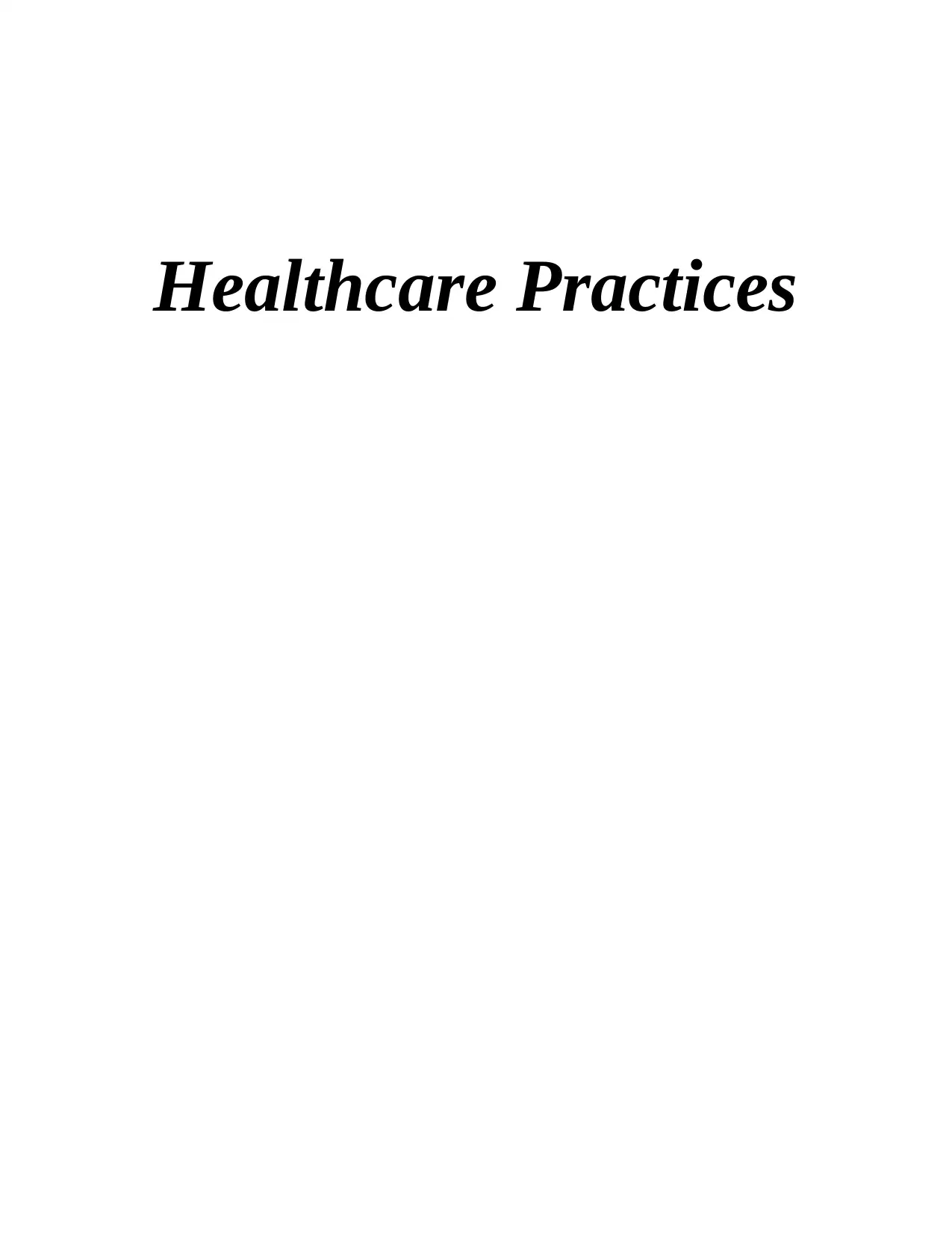
Healthcare Practices
Paraphrase This Document
Need a fresh take? Get an instant paraphrase of this document with our AI Paraphraser
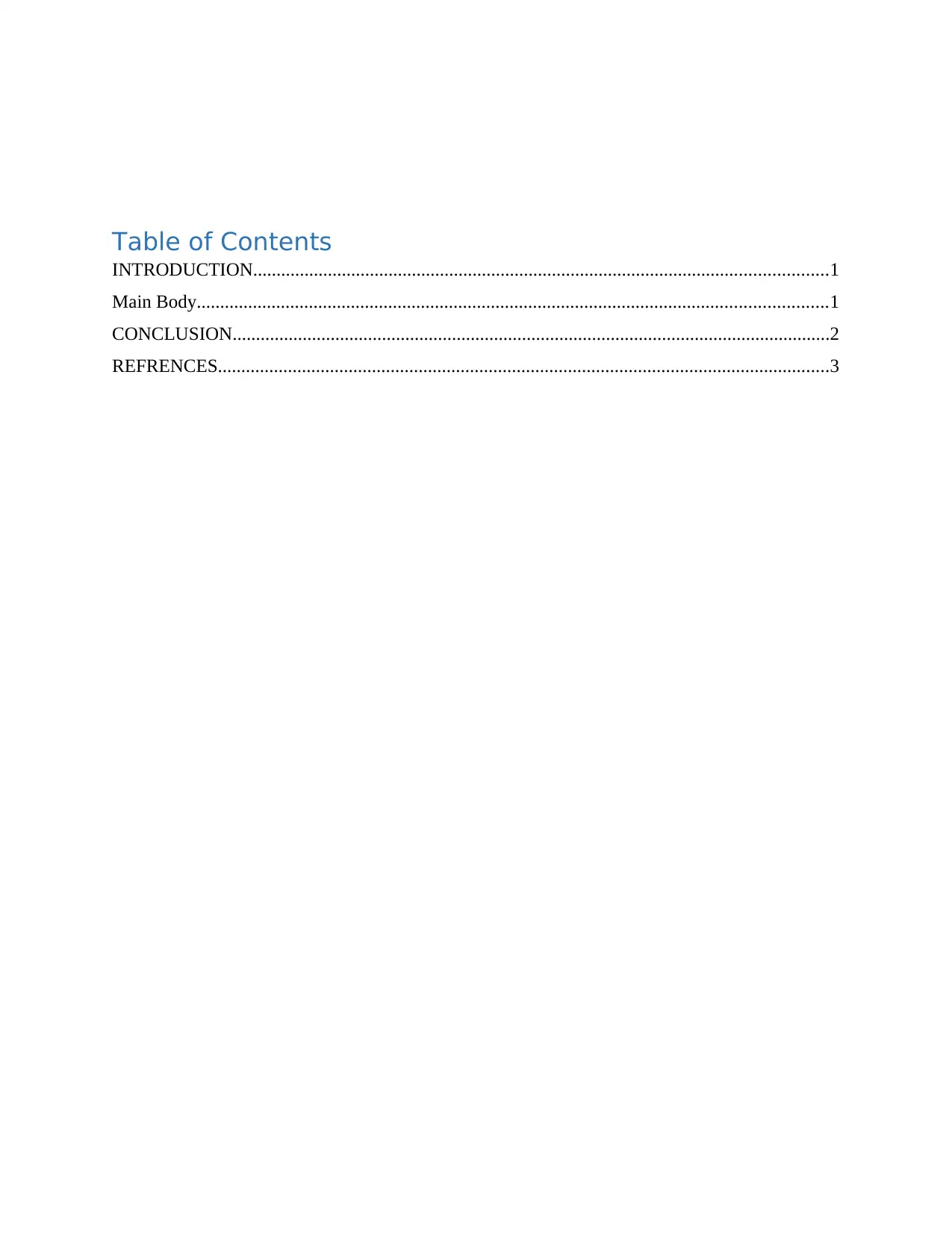
Table of Contents
INTRODUCTION...........................................................................................................................1
Main Body.......................................................................................................................................1
CONCLUSION................................................................................................................................2
REFRENCES...................................................................................................................................3
INTRODUCTION...........................................................................................................................1
Main Body.......................................................................................................................................1
CONCLUSION................................................................................................................................2
REFRENCES...................................................................................................................................3
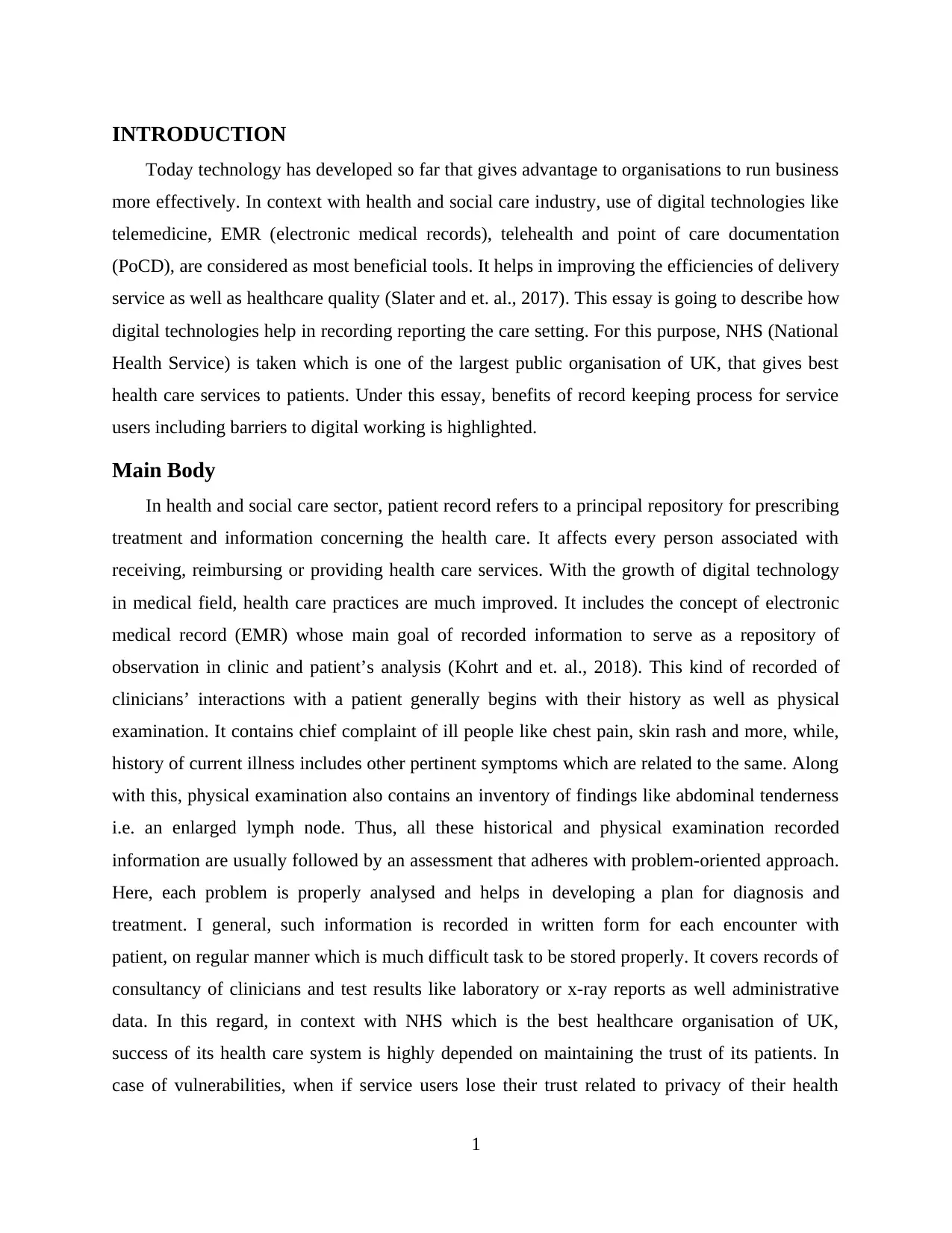
INTRODUCTION
Today technology has developed so far that gives advantage to organisations to run business
more effectively. In context with health and social care industry, use of digital technologies like
telemedicine, EMR (electronic medical records), telehealth and point of care documentation
(PoCD), are considered as most beneficial tools. It helps in improving the efficiencies of delivery
service as well as healthcare quality (Slater and et. al., 2017). This essay is going to describe how
digital technologies help in recording reporting the care setting. For this purpose, NHS (National
Health Service) is taken which is one of the largest public organisation of UK, that gives best
health care services to patients. Under this essay, benefits of record keeping process for service
users including barriers to digital working is highlighted.
Main Body
In health and social care sector, patient record refers to a principal repository for prescribing
treatment and information concerning the health care. It affects every person associated with
receiving, reimbursing or providing health care services. With the growth of digital technology
in medical field, health care practices are much improved. It includes the concept of electronic
medical record (EMR) whose main goal of recorded information to serve as a repository of
observation in clinic and patient’s analysis (Kohrt and et. al., 2018). This kind of recorded of
clinicians’ interactions with a patient generally begins with their history as well as physical
examination. It contains chief complaint of ill people like chest pain, skin rash and more, while,
history of current illness includes other pertinent symptoms which are related to the same. Along
with this, physical examination also contains an inventory of findings like abdominal tenderness
i.e. an enlarged lymph node. Thus, all these historical and physical examination recorded
information are usually followed by an assessment that adheres with problem-oriented approach.
Here, each problem is properly analysed and helps in developing a plan for diagnosis and
treatment. I general, such information is recorded in written form for each encounter with
patient, on regular manner which is much difficult task to be stored properly. It covers records of
consultancy of clinicians and test results like laboratory or x-ray reports as well administrative
data. In this regard, in context with NHS which is the best healthcare organisation of UK,
success of its health care system is highly depended on maintaining the trust of its patients. In
case of vulnerabilities, when if service users lose their trust related to privacy of their health
1
Today technology has developed so far that gives advantage to organisations to run business
more effectively. In context with health and social care industry, use of digital technologies like
telemedicine, EMR (electronic medical records), telehealth and point of care documentation
(PoCD), are considered as most beneficial tools. It helps in improving the efficiencies of delivery
service as well as healthcare quality (Slater and et. al., 2017). This essay is going to describe how
digital technologies help in recording reporting the care setting. For this purpose, NHS (National
Health Service) is taken which is one of the largest public organisation of UK, that gives best
health care services to patients. Under this essay, benefits of record keeping process for service
users including barriers to digital working is highlighted.
Main Body
In health and social care sector, patient record refers to a principal repository for prescribing
treatment and information concerning the health care. It affects every person associated with
receiving, reimbursing or providing health care services. With the growth of digital technology
in medical field, health care practices are much improved. It includes the concept of electronic
medical record (EMR) whose main goal of recorded information to serve as a repository of
observation in clinic and patient’s analysis (Kohrt and et. al., 2018). This kind of recorded of
clinicians’ interactions with a patient generally begins with their history as well as physical
examination. It contains chief complaint of ill people like chest pain, skin rash and more, while,
history of current illness includes other pertinent symptoms which are related to the same. Along
with this, physical examination also contains an inventory of findings like abdominal tenderness
i.e. an enlarged lymph node. Thus, all these historical and physical examination recorded
information are usually followed by an assessment that adheres with problem-oriented approach.
Here, each problem is properly analysed and helps in developing a plan for diagnosis and
treatment. I general, such information is recorded in written form for each encounter with
patient, on regular manner which is much difficult task to be stored properly. It covers records of
consultancy of clinicians and test results like laboratory or x-ray reports as well administrative
data. In this regard, in context with NHS which is the best healthcare organisation of UK,
success of its health care system is highly depended on maintaining the trust of its patients. In
case of vulnerabilities, when if service users lose their trust related to privacy of their health
1
⊘ This is a preview!⊘
Do you want full access?
Subscribe today to unlock all pages.

Trusted by 1+ million students worldwide
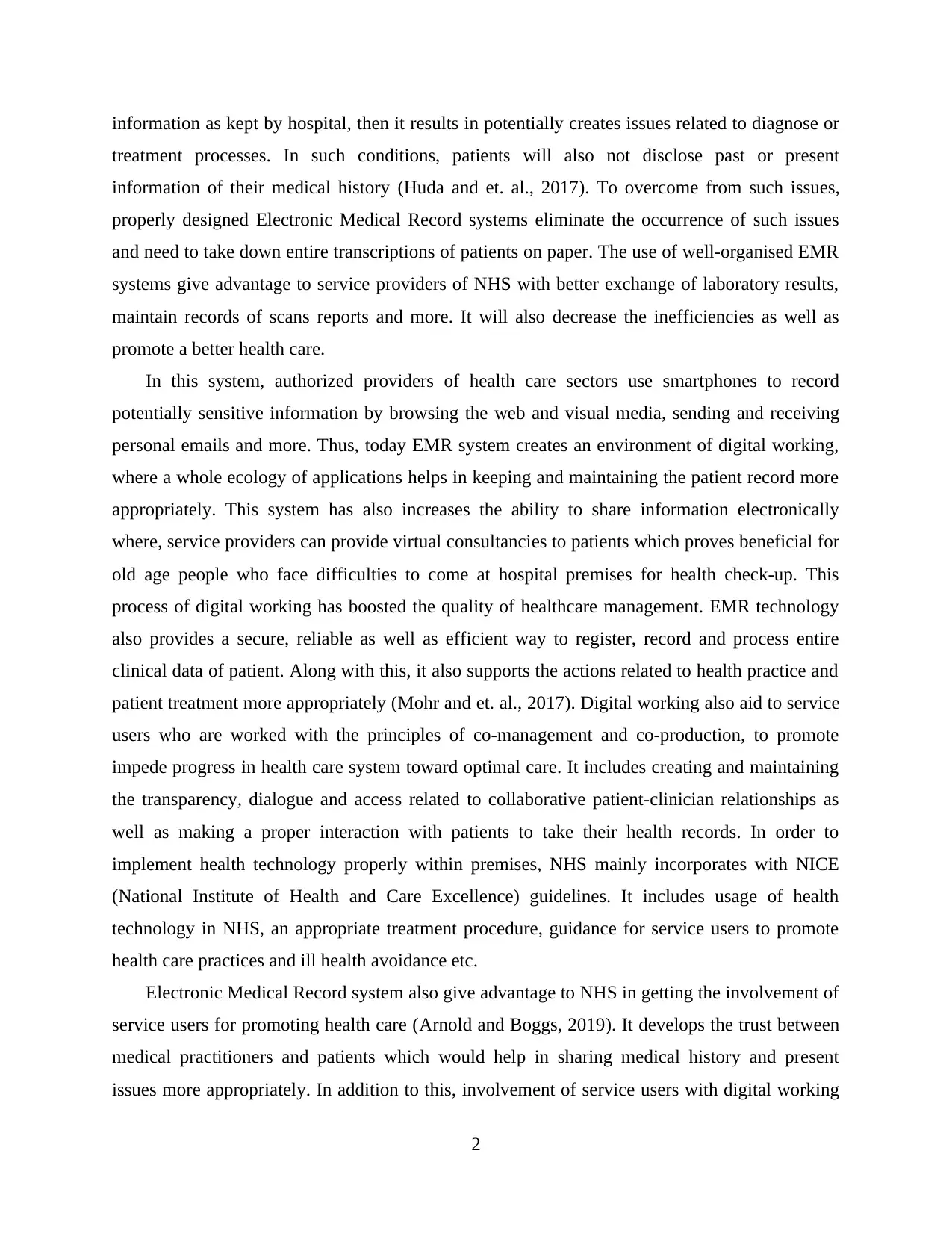
information as kept by hospital, then it results in potentially creates issues related to diagnose or
treatment processes. In such conditions, patients will also not disclose past or present
information of their medical history (Huda and et. al., 2017). To overcome from such issues,
properly designed Electronic Medical Record systems eliminate the occurrence of such issues
and need to take down entire transcriptions of patients on paper. The use of well-organised EMR
systems give advantage to service providers of NHS with better exchange of laboratory results,
maintain records of scans reports and more. It will also decrease the inefficiencies as well as
promote a better health care.
In this system, authorized providers of health care sectors use smartphones to record
potentially sensitive information by browsing the web and visual media, sending and receiving
personal emails and more. Thus, today EMR system creates an environment of digital working,
where a whole ecology of applications helps in keeping and maintaining the patient record more
appropriately. This system has also increases the ability to share information electronically
where, service providers can provide virtual consultancies to patients which proves beneficial for
old age people who face difficulties to come at hospital premises for health check-up. This
process of digital working has boosted the quality of healthcare management. EMR technology
also provides a secure, reliable as well as efficient way to register, record and process entire
clinical data of patient. Along with this, it also supports the actions related to health practice and
patient treatment more appropriately (Mohr and et. al., 2017). Digital working also aid to service
users who are worked with the principles of co-management and co-production, to promote
impede progress in health care system toward optimal care. It includes creating and maintaining
the transparency, dialogue and access related to collaborative patient-clinician relationships as
well as making a proper interaction with patients to take their health records. In order to
implement health technology properly within premises, NHS mainly incorporates with NICE
(National Institute of Health and Care Excellence) guidelines. It includes usage of health
technology in NHS, an appropriate treatment procedure, guidance for service users to promote
health care practices and ill health avoidance etc.
Electronic Medical Record system also give advantage to NHS in getting the involvement of
service users for promoting health care (Arnold and Boggs, 2019). It develops the trust between
medical practitioners and patients which would help in sharing medical history and present
issues more appropriately. In addition to this, involvement of service users with digital working
2
treatment processes. In such conditions, patients will also not disclose past or present
information of their medical history (Huda and et. al., 2017). To overcome from such issues,
properly designed Electronic Medical Record systems eliminate the occurrence of such issues
and need to take down entire transcriptions of patients on paper. The use of well-organised EMR
systems give advantage to service providers of NHS with better exchange of laboratory results,
maintain records of scans reports and more. It will also decrease the inefficiencies as well as
promote a better health care.
In this system, authorized providers of health care sectors use smartphones to record
potentially sensitive information by browsing the web and visual media, sending and receiving
personal emails and more. Thus, today EMR system creates an environment of digital working,
where a whole ecology of applications helps in keeping and maintaining the patient record more
appropriately. This system has also increases the ability to share information electronically
where, service providers can provide virtual consultancies to patients which proves beneficial for
old age people who face difficulties to come at hospital premises for health check-up. This
process of digital working has boosted the quality of healthcare management. EMR technology
also provides a secure, reliable as well as efficient way to register, record and process entire
clinical data of patient. Along with this, it also supports the actions related to health practice and
patient treatment more appropriately (Mohr and et. al., 2017). Digital working also aid to service
users who are worked with the principles of co-management and co-production, to promote
impede progress in health care system toward optimal care. It includes creating and maintaining
the transparency, dialogue and access related to collaborative patient-clinician relationships as
well as making a proper interaction with patients to take their health records. In order to
implement health technology properly within premises, NHS mainly incorporates with NICE
(National Institute of Health and Care Excellence) guidelines. It includes usage of health
technology in NHS, an appropriate treatment procedure, guidance for service users to promote
health care practices and ill health avoidance etc.
Electronic Medical Record system also give advantage to NHS in getting the involvement of
service users for promoting health care (Arnold and Boggs, 2019). It develops the trust between
medical practitioners and patients which would help in sharing medical history and present
issues more appropriately. In addition to this, involvement of service users with digital working
2
Paraphrase This Document
Need a fresh take? Get an instant paraphrase of this document with our AI Paraphraser
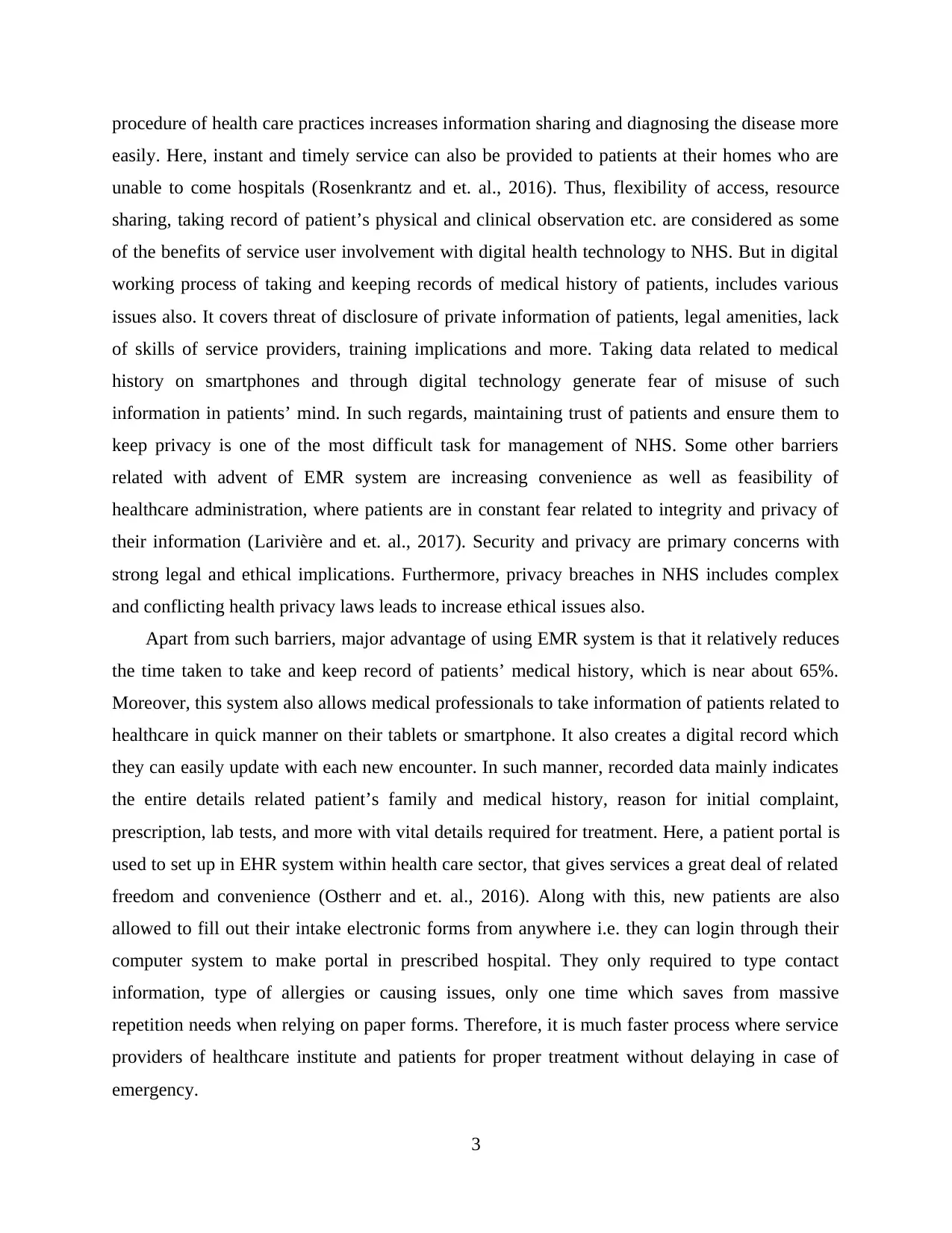
procedure of health care practices increases information sharing and diagnosing the disease more
easily. Here, instant and timely service can also be provided to patients at their homes who are
unable to come hospitals (Rosenkrantz and et. al., 2016). Thus, flexibility of access, resource
sharing, taking record of patient’s physical and clinical observation etc. are considered as some
of the benefits of service user involvement with digital health technology to NHS. But in digital
working process of taking and keeping records of medical history of patients, includes various
issues also. It covers threat of disclosure of private information of patients, legal amenities, lack
of skills of service providers, training implications and more. Taking data related to medical
history on smartphones and through digital technology generate fear of misuse of such
information in patients’ mind. In such regards, maintaining trust of patients and ensure them to
keep privacy is one of the most difficult task for management of NHS. Some other barriers
related with advent of EMR system are increasing convenience as well as feasibility of
healthcare administration, where patients are in constant fear related to integrity and privacy of
their information (Larivière and et. al., 2017). Security and privacy are primary concerns with
strong legal and ethical implications. Furthermore, privacy breaches in NHS includes complex
and conflicting health privacy laws leads to increase ethical issues also.
Apart from such barriers, major advantage of using EMR system is that it relatively reduces
the time taken to take and keep record of patients’ medical history, which is near about 65%.
Moreover, this system also allows medical professionals to take information of patients related to
healthcare in quick manner on their tablets or smartphone. It also creates a digital record which
they can easily update with each new encounter. In such manner, recorded data mainly indicates
the entire details related patient’s family and medical history, reason for initial complaint,
prescription, lab tests, and more with vital details required for treatment. Here, a patient portal is
used to set up in EHR system within health care sector, that gives services a great deal of related
freedom and convenience (Ostherr and et. al., 2016). Along with this, new patients are also
allowed to fill out their intake electronic forms from anywhere i.e. they can login through their
computer system to make portal in prescribed hospital. They only required to type contact
information, type of allergies or causing issues, only one time which saves from massive
repetition needs when relying on paper forms. Therefore, it is much faster process where service
providers of healthcare institute and patients for proper treatment without delaying in case of
emergency.
3
easily. Here, instant and timely service can also be provided to patients at their homes who are
unable to come hospitals (Rosenkrantz and et. al., 2016). Thus, flexibility of access, resource
sharing, taking record of patient’s physical and clinical observation etc. are considered as some
of the benefits of service user involvement with digital health technology to NHS. But in digital
working process of taking and keeping records of medical history of patients, includes various
issues also. It covers threat of disclosure of private information of patients, legal amenities, lack
of skills of service providers, training implications and more. Taking data related to medical
history on smartphones and through digital technology generate fear of misuse of such
information in patients’ mind. In such regards, maintaining trust of patients and ensure them to
keep privacy is one of the most difficult task for management of NHS. Some other barriers
related with advent of EMR system are increasing convenience as well as feasibility of
healthcare administration, where patients are in constant fear related to integrity and privacy of
their information (Larivière and et. al., 2017). Security and privacy are primary concerns with
strong legal and ethical implications. Furthermore, privacy breaches in NHS includes complex
and conflicting health privacy laws leads to increase ethical issues also.
Apart from such barriers, major advantage of using EMR system is that it relatively reduces
the time taken to take and keep record of patients’ medical history, which is near about 65%.
Moreover, this system also allows medical professionals to take information of patients related to
healthcare in quick manner on their tablets or smartphone. It also creates a digital record which
they can easily update with each new encounter. In such manner, recorded data mainly indicates
the entire details related patient’s family and medical history, reason for initial complaint,
prescription, lab tests, and more with vital details required for treatment. Here, a patient portal is
used to set up in EHR system within health care sector, that gives services a great deal of related
freedom and convenience (Ostherr and et. al., 2016). Along with this, new patients are also
allowed to fill out their intake electronic forms from anywhere i.e. they can login through their
computer system to make portal in prescribed hospital. They only required to type contact
information, type of allergies or causing issues, only one time which saves from massive
repetition needs when relying on paper forms. Therefore, it is much faster process where service
providers of healthcare institute and patients for proper treatment without delaying in case of
emergency.
3
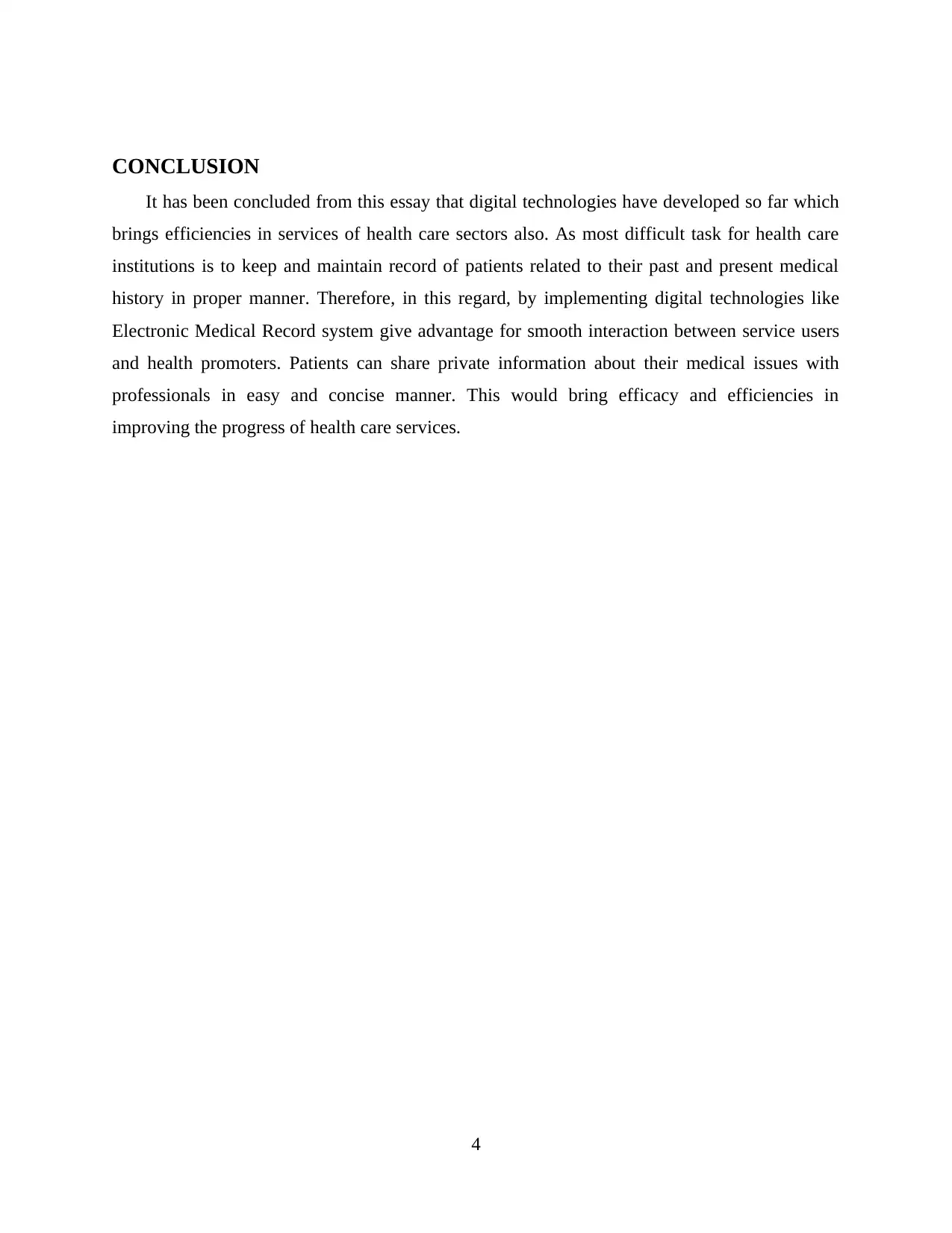
CONCLUSION
It has been concluded from this essay that digital technologies have developed so far which
brings efficiencies in services of health care sectors also. As most difficult task for health care
institutions is to keep and maintain record of patients related to their past and present medical
history in proper manner. Therefore, in this regard, by implementing digital technologies like
Electronic Medical Record system give advantage for smooth interaction between service users
and health promoters. Patients can share private information about their medical issues with
professionals in easy and concise manner. This would bring efficacy and efficiencies in
improving the progress of health care services.
4
It has been concluded from this essay that digital technologies have developed so far which
brings efficiencies in services of health care sectors also. As most difficult task for health care
institutions is to keep and maintain record of patients related to their past and present medical
history in proper manner. Therefore, in this regard, by implementing digital technologies like
Electronic Medical Record system give advantage for smooth interaction between service users
and health promoters. Patients can share private information about their medical issues with
professionals in easy and concise manner. This would bring efficacy and efficiencies in
improving the progress of health care services.
4
⊘ This is a preview!⊘
Do you want full access?
Subscribe today to unlock all pages.

Trusted by 1+ million students worldwide
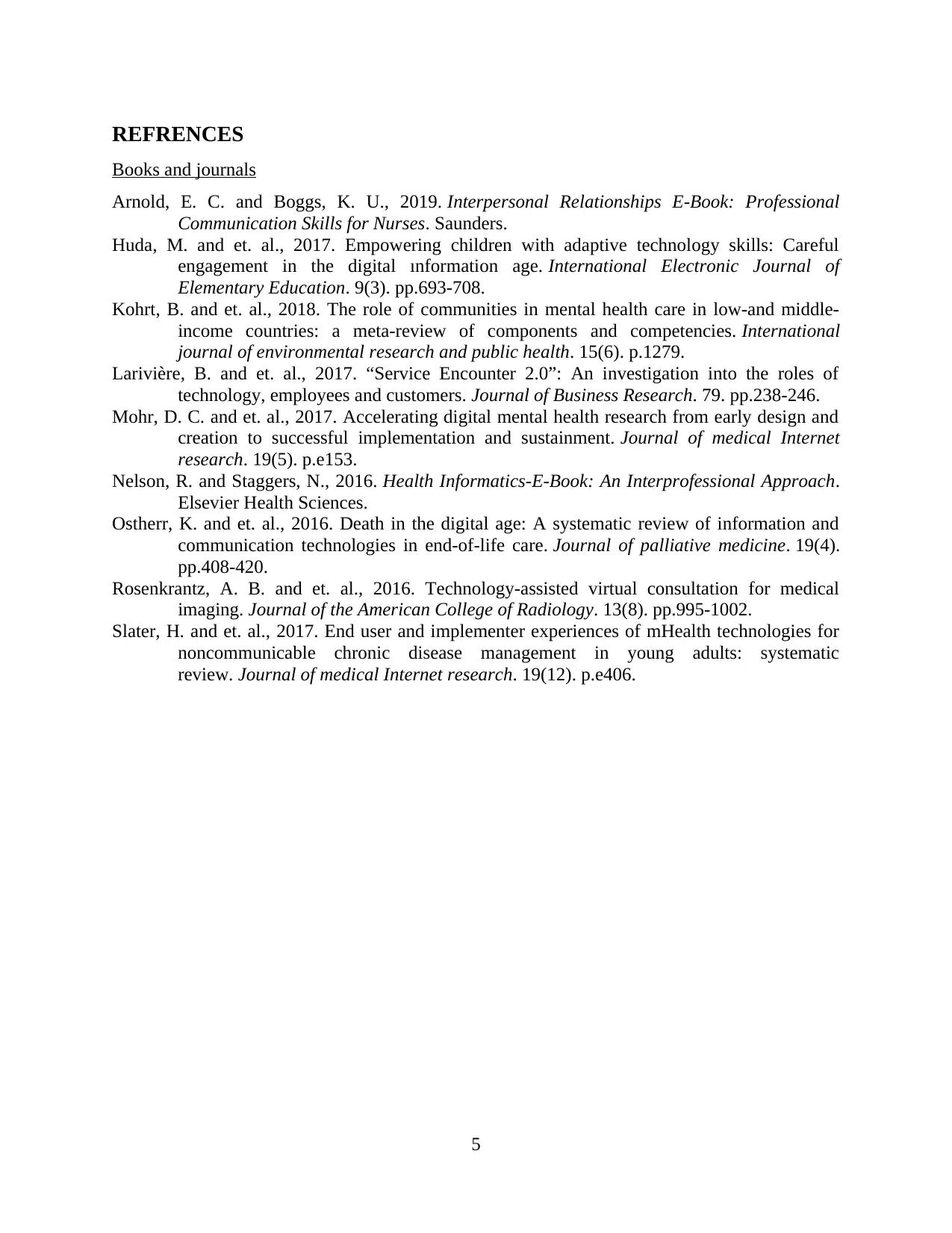
REFRENCES
Books and journals
Arnold, E. C. and Boggs, K. U., 2019. Interpersonal Relationships E-Book: Professional
Communication Skills for Nurses. Saunders.
Huda, M. and et. al., 2017. Empowering children with adaptive technology skills: Careful
engagement in the digital ınformation age. International Electronic Journal of
Elementary Education. 9(3). pp.693-708.
Kohrt, B. and et. al., 2018. The role of communities in mental health care in low-and middle-
income countries: a meta-review of components and competencies. International
journal of environmental research and public health. 15(6). p.1279.
Larivière, B. and et. al., 2017. “Service Encounter 2.0”: An investigation into the roles of
technology, employees and customers. Journal of Business Research. 79. pp.238-246.
Mohr, D. C. and et. al., 2017. Accelerating digital mental health research from early design and
creation to successful implementation and sustainment. Journal of medical Internet
research. 19(5). p.e153.
Nelson, R. and Staggers, N., 2016. Health Informatics-E-Book: An Interprofessional Approach.
Elsevier Health Sciences.
Ostherr, K. and et. al., 2016. Death in the digital age: A systematic review of information and
communication technologies in end-of-life care. Journal of palliative medicine. 19(4).
pp.408-420.
Rosenkrantz, A. B. and et. al., 2016. Technology-assisted virtual consultation for medical
imaging. Journal of the American College of Radiology. 13(8). pp.995-1002.
Slater, H. and et. al., 2017. End user and implementer experiences of mHealth technologies for
noncommunicable chronic disease management in young adults: systematic
review. Journal of medical Internet research. 19(12). p.e406.
5
Books and journals
Arnold, E. C. and Boggs, K. U., 2019. Interpersonal Relationships E-Book: Professional
Communication Skills for Nurses. Saunders.
Huda, M. and et. al., 2017. Empowering children with adaptive technology skills: Careful
engagement in the digital ınformation age. International Electronic Journal of
Elementary Education. 9(3). pp.693-708.
Kohrt, B. and et. al., 2018. The role of communities in mental health care in low-and middle-
income countries: a meta-review of components and competencies. International
journal of environmental research and public health. 15(6). p.1279.
Larivière, B. and et. al., 2017. “Service Encounter 2.0”: An investigation into the roles of
technology, employees and customers. Journal of Business Research. 79. pp.238-246.
Mohr, D. C. and et. al., 2017. Accelerating digital mental health research from early design and
creation to successful implementation and sustainment. Journal of medical Internet
research. 19(5). p.e153.
Nelson, R. and Staggers, N., 2016. Health Informatics-E-Book: An Interprofessional Approach.
Elsevier Health Sciences.
Ostherr, K. and et. al., 2016. Death in the digital age: A systematic review of information and
communication technologies in end-of-life care. Journal of palliative medicine. 19(4).
pp.408-420.
Rosenkrantz, A. B. and et. al., 2016. Technology-assisted virtual consultation for medical
imaging. Journal of the American College of Radiology. 13(8). pp.995-1002.
Slater, H. and et. al., 2017. End user and implementer experiences of mHealth technologies for
noncommunicable chronic disease management in young adults: systematic
review. Journal of medical Internet research. 19(12). p.e406.
5
1 out of 7
Related Documents
Your All-in-One AI-Powered Toolkit for Academic Success.
+13062052269
info@desklib.com
Available 24*7 on WhatsApp / Email
![[object Object]](/_next/static/media/star-bottom.7253800d.svg)
Unlock your academic potential
Copyright © 2020–2025 A2Z Services. All Rights Reserved. Developed and managed by ZUCOL.





